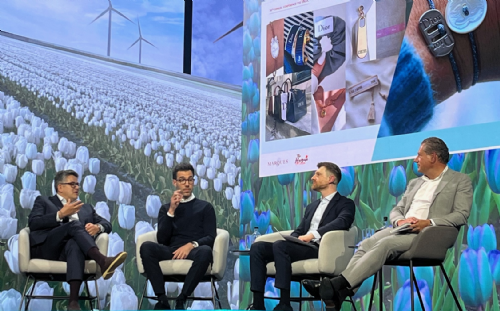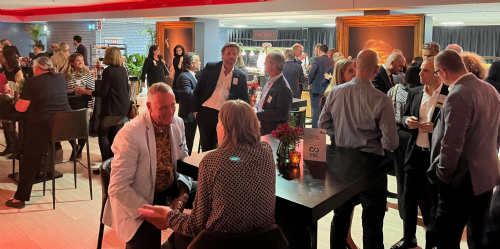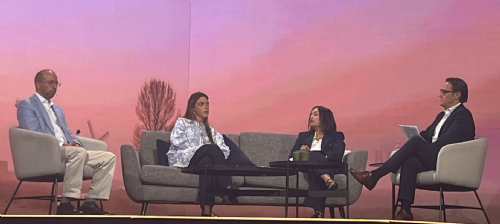Now in its twelfth year, Class 46 is dedicated to European trade mark law and practice. This weblog is written by a team of enthusiasts who want to spread the word and share their thoughts with others.
Click here subscribe for free.
Who we all are...
39th Annual Conference: parts 3 and 4
 |
| Leo Longauer, Pablo Vanel, Professor Lukasz Zelechowski and Tobias Cohen Jehoram |
Parallel trade, the second hand market, repair/refurbishment, the circular economy and trade mark exhaustion were all on the menu in part 3 of this year’s Annual Conference in The Hague: “Brands in international trade”. The panel was moderated by Tobias Cohen Jehoram, De Brauw Blackstone Westbroek, The Netherlands and Member of the MARQUES Council.
In his presentation, Professor Lukasz Zelechowski, University of Warsaw, Poland focused on de-branding, exhaustion and the circular economy, and exhaustion in the metaverse. He discussed cases including C-555/08 Portakabin and C-129/17 Mitsubishi, and noted the controversial conclusion in the latter case: “De-branding whether or not followed by re-branding could hardly be considered as not constituting a legitimate reason to oppose further commercialisation.” In reaching its finding, he said the Court was striving towards uniformity. Prof Zelechowski added that de-branding is covered by the exclusive right in countries such as France and Italy but not in other EU Member States.
However, he raised doubts about whether de-branding fits into the concept of actionable use and whether there is interference with the origin function. He also queried where the current legal framework sits in regard to de-branding for sustainability reasons. “De-branding seems more like a separate sui generis form of exclusivity,” he said. “It’s something more than a regular trade mark exclusivity. The question is political: do we want that exclusivity or not?”
 |
| Tuesday evening's Welcome Reception in the World Forum, The Hague |
Turning to circular economy products, he summarised the recent EU legislation in this area. “This is a trade mark law issue because materials used in circular practices may contain a trade mark,” he said. The question therefore arises: which “legitimate reasons” might prevent trade mark exhaustion? There was a missed opportunity for guidance on this question in the CJEU case in EPAL. “We would likely have to move from exhaustion to infringement criteria and exceptions and limitations,” said Prof Zelechowski.
Following on, Pablo Vanel, Western Digital UK Ltd, a manufacturer of hard disk drives, discussed the two main challenges he faces: parallel trade and import of counterfeit products.
He said that parallel trade has a significant impact on the company’s business, by eroding market share, undermining local pricing strategies and disrupting market stability – ultimately undermining profitability. Western Digital responds to this by monitoring online platforms, carrying out online enforcement and investigating sellers. “The last resort is litigation,” he said.
Pablo also discussed the CJEU decision in HP v Senetic and the sale of unauthorised refurbished and re-labelled products, which are sold as “new” products to consumers. In Fennia v Philips, he said, the trade mark holder was deemed to be the producer of the goods and liable under the product liability directive.
Finally, Leo Longauer, LVMH, France and 1st Vice-Chair of the MARQUES Council, focused on the buying and selling of goods in the second-hand market. “This is more than a trend,” he said, and offers several advantages to customers such as availability, affordability and accessibility. But the risks include counterfeiting, return fraud, trade mark and copyright infringement, and upcycling. Further risks to businesses include impact on brand perception and lost sales.
Counterfeits are growing in availability and quality, making authentication more difficult. “No one except the brand owner can say whether or not something is authentic,” said Leo. However there are some positive signs for brand owners: in the US, Chanel won $4 million in damages in a case against What Goes Around Comes Around, which was selling vintage and pre-owned luxury goods.
Upcycling is the process of modifying existing products for resale. “There is a tension between the interests of IP holders and free circulation of trade,” said Leo. The US case Rolex v La Californienne was decided in favour of the brand owner and in PRS USA Holdings v VNDS, a California court found that hats made from Ralph Lauren swim shorts were clearly different from the original product and the brand owner was granted an injunction and $800,000 in damages.
Sustainability in IP
 |
| Sebastien Vitali, Virginia Cervieri, Susana Fernandez Martin and Chris Thomae |
The first day’s final part, “The rise of sustainability in IP” looked at various green initiative and their significance for IP.
Susana Fernandez Martin, INDITEX, S.A., Spain, Member of MARQUES Council and Cyberspace Team, described how the company ensures a low level of surplus goods. It aims to minimise the environmental impact in product design, manufacturing, distribution and retail, use and end of life.
Virginia Cervieri, Cervieri Monsuarez, Uruguay, Member of the MARQUES Anti-Counterfeiting & Parallel Trade Team, described the Be Green, Take Action campaign to transform waste into new products. One of its campaigns, Entre Manos, converts seized counterfeit merchandise into useful products. Another, Score Green, recycles counterfeit plastic into sustainable basketball boards.
Sebastien Vitali, Johnson Controls, Switzerland, Member of MARQUES Council and Member of the Amicus Curiae Team, talked about the “trifecta” to reduce carbon emissions and operational costs in buildings: building efficiency, electrification and digitalisation. He asked: how does this connect with IP? One way is that the company made a commitment to invest at least 75% of new product R&D in climate-related innovation. In 2024, the proportion was 88%. It has several innovation initiatives to achieve this.
Moderator Chris Thomae, Dumont, Mexico, and Member of the MARQUES Programming Team, led a discussion among the panel on questions such as: how do you ensure that the IP team is involved in sustainability initiatives? How do you coordinate the legal, engineering and other teams? How do you approach collaborations? And how do you measure success when it comes to aligning IP with sustainability goals?
Posted by: Blog Administrator @ 06.34Tags: The Hague, Annual Conference, sustainability, Mitsubishi,


 Sharing on Social Media? Use the link below...
Sharing on Social Media? Use the link below...Perm-A-Link: https://www.marques.org/blogs/class46?XID=BHA5383

